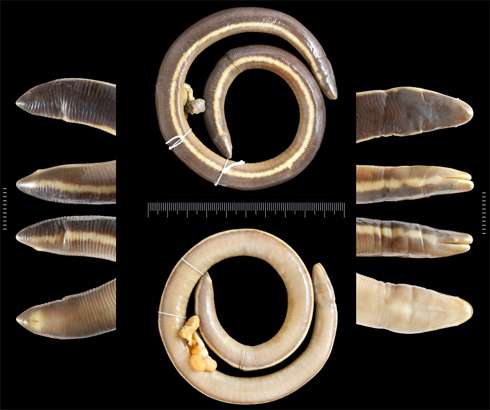Scientists have named the 200th caecilian species

Natural History Museum scientists have named the 200th caecilian species, marking a landmark in our understanding of this enigmatic group of amphibians.
Caecilians are a little-known group of amphibians that superficially look like a cross between a worm and snake.
Their secretive burrowing lifestyle and range restricted to the tropics mean they can be extremely hard to study, but a dedicated team at the Museum has been leading the way and has succeeded in describing the 200th species.
It is also the first caecilian species to be found in Myanmar, south east Asia, which sits between known populations of other species in surrounding countries.
Seeking caecilians
Basic knowledge of the planet's biodiversity is constantly increasing as scientists discover new species, but the rates of discovery depend not only on how many species there actually are, but on how difficult they are to study and how much attention is paid to them.
Over the past couple of decades the number of other amphibian species discovered has increased rapidly. The number of frogs and toads has nearly doubled to around 6,400 species. But since the 1980s there has been only a 12 per cent increase in the number of caecilians.
Museum scientists Dr Mark Wilkinson and Dr David Gower and colleagues have described around 25 new species of caecilian in the past 15 years, and are responsible for identifying many of the new species discovered since the 1980s.
Wilkinson and Gower predict there could be another 100 species of caecilian, and they are keen to discover them.
The newest member, Ichthyophis multicolor, was discovered in Myanmar by scientists from the California Academy of Sciences who asked the Museum to identify it. It is described in the international journal Zootaxa.
Rewarding mysteries
'When there's not a lot known about a group, sometimes people make the mistake of thinking there's not a lot to know about them,' said Dr Wilkinson.
Caecilians however have a lot of weird and wonderful properties that reward study, such as a sensitive tentacle that likely evolved out of unused components of the eye, and scales that form in pockets under the skin, rather than on the outside.
'They have a lot of strange features, and because they are a poorly known group the adaptive significance of those features is not well understood,' said Dr Wilkinson.
It's not even particularly well known what caecilians do in the soil and how they impact their local environment.
Because they don't leave any indicators on the surface of where they've been, most discoveries are made by talking to local people or, in uninhabited jungles, by simply digging. 'It can be a bit hit and miss and might seem a bit crazy,' admits Dr Wilkinson.
Saving caecilians
Caecilians may also harbour useful biomedical products. Other amphibians, such as frogs, have a library of antimicrobial compounds in their skin that could lead to new drugs for us.
Dr Wilkinson hopes that habitat destruction and extinction don't interfere with new caecilian discoveries, whether they prove useful or simply amazing.
'I don't like things going extinct especially before we've studied them, because then we've lost another irreplaceable opportunity to increase our understanding of the world.'
Journal information: Zootaxa
Provided by Natural History Museum

















